My Facial Feminisation Thesis
Part 1:
Common Misconceptions
I have one advantage over surgeons - I can try out procedures in Photoshop to see if they help, and if they don't, I can simply undo them, and it was through this kind of experimentation that I started to realise that some of the widely held ideas about facial gender and FFS might not be entirely correct. Let me give you an example:
It is widely believed in FFS circles that a male hairline is higher and has an “M” shape while a female hairline is lower and has a rounded shape. The shape difference is very true – female hairlines do tend to be more rounded whilst male hairlines are more “M” shaped or square - but the key thing I observed was that lowering the hairline didn't seem to have a feminising effect in many of the cases I was working on. I looked at the available research for answers, but there was very little of it, so I then turned to "prototypes" which are averaged faces (more on those later) and discovered that in fact, male hairlines are proportionately a little lower in the middle than female hairlines.
Men do sometimes have a higher hairline in the middle if they have been affected by male pattern baldness (MPB) but the height in the centre is often not affected by MPB.
You can see the height issue for yourself In these prototypes:
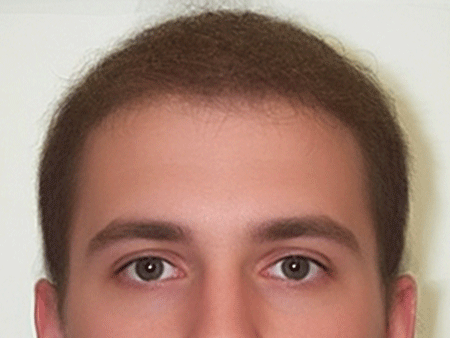
So why do so many people believe men's hairlines are higher in the middle, and not just in the corners? I suspect that it mainly comes down to an optical illusion caused by the shape of the hairline rather than the actual height of the hairline in the middle. Let me show you:
Most people are familiar with the following optical illusion where the vertical line is the same length in both figures, but the one on the right looks longer than the one on the left because of the way that the arrow shapes at the tops and bottoms of the lines deceive your eyes:
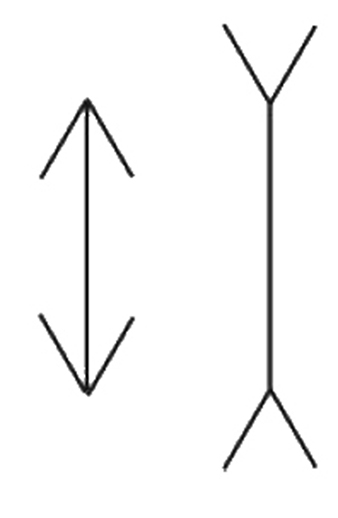
Now look at this abstract representation of 2 identical faces. The vertical line represents the height of the face:
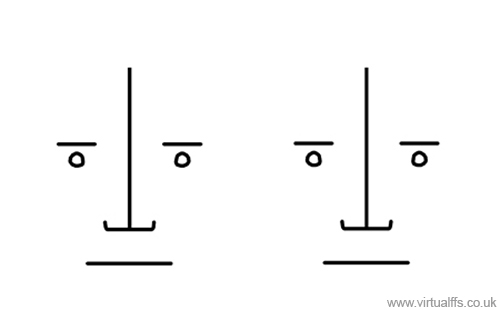
And now look what happens when you add a female-shaped hairline to the left one, and male-shaped hairline to the right one:
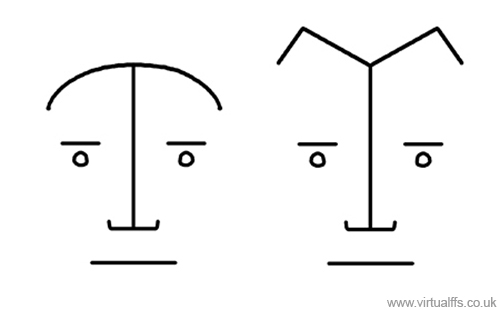
Both hairlines are the same height in the middle, but shape of the male hairline makes it look like it's higher in the middle than the female hairline.
Despite the evidence of the prototypes, there are at least some studies based on facial measurements that do suggest female hairlines are lower, One possible reason is that examples of male pattern baldness have gotten into studies where hairline heights are averaged. That would skew the results.
Another possibility is that the absolute height of a female hairline in millimetres might actually be less than in males because women are on average smaller than men, but of course, it's the proportional height that matters rather than the absolute height..
The results may also vary depending on whether you account for the tendency for male foreheads to slope backwards a little or if you use a tape measure that follows the contours of the brow bossing meaning the tape has to cover a larger distance to reach the hairline.
However, I have not yet had a chance to do an in-depth study to find out why these studies disagree with the evidence of the prototypes.
The fact that many patients and surgeons believe women to have lower hairlines in the middle causes a problem in FFS because patients sometimes end up having surgery to move the hairline forwards, leaving them with a hairline that is unnaturally low and that also has a visible scar running along it.
Another complicating factor here is that males tend to have a taller lower third to their face so the distance between their nose and their chin is longer in relation to the rest of their face than it is in women. This long lower third can be emphasised by having a short upper third so, in other words, a low hairline can make your jaw and chin look taller and that can be masculinising, and this in turn means that a slightly higher hairline than the male average can actually be an advantage for some trans women rather than the problem that many assume.
However, although male hairlines sit a little lower on average than female ones, it's not a huge difference and the average male hairline would still fit into a wider range of typical female hairlines. The problem comes when you take one of these average male hairlines and lower it further - you then run the risk of taking it beyond the lower range of female hairlines into an area that is so low, it is usually only seen on men. In addition to that, if you move it forwards with a scalp advance, you have to consider the visible scar along the hairline.
Although changing the height of the hairline is often unnecessary, changing the shape of the hairline from “M” shaped or square to a rounded shape often does make a big difference to facial femininity, so I have to round off the corners of the hairline in perhaps the majority of my clients. This leads me to one of my key beliefs about FFS:
Some masculinities are more important than others.
In this case then, the shape of the hairline is much more important than the height. I'll have more to say on the relative importance of different masculinities in part 7 of this thesis “Objective and Subjective femininity” and you can read more about the hairline in part 5 “relative proportions” under the "lipuhai rule".
Another common misconception in FFS is that women have much higher eyebrows than men but this is misleading because the top edge of the eyebrows is at about the same height in both men and women, or only very slightly higher in women. The key reason people think that women's eyebrows are higher overall is that female eyebrows are thinner (partly or mainly due to being plucked along the underside) so that the bottom edge of the eyebrow sits in a higher position and creates a bigger gap between the eye and the eyebrow.
If we look at prototypes we can see that the top edge is at the same height in both sexes:
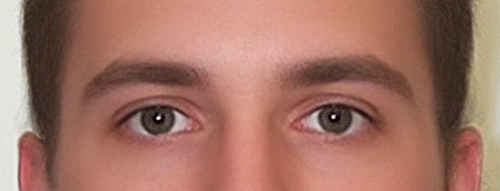
The jaw corners are another example: the size and shape of the jaw corners are one of the key differences between male and female skulls with male jaw corners being larger and squarer as seen from the side. I believe that these differences in the jaw, although useful in anthropology and archaeology, are not as important in FFS and that surgery to the round off the jaw corners is often more optional than people assume. There are 2 main reasons for this:
1. The square shape of the jaw corners is reasonably well hidden by soft tissues and doesn't show through particularly clearly in many people.
2. The squareness is seen from the side and the side of the face does not get a lot of attention in human interactions – our attention is more focused on the front of the face, particularly the eyes and mouth.
Another key issue with jaws is that many people expect men's jaws to be wider in relation to their cheeks than women's but in fact, the width of the jaw relative to the width of the cheeks tends, on average, to be almost exactly the same for both sexes. Relatively wide and square jaw angles are also common on women who are considered particularly beautiful as this picture illustrates:
Picture courtesy of Remy Stenegger
Please use the links below to navigate around the thesis:
Part 2: The Established Research
Part 4: Sexual Dimorphism of the Face Feature by Feature
Part 6: Female Neoteny and Feminisation as a Subtractive Process
Part 7: Objective and Subjective Femininity
Part 8: How Feminine is Feminine Enough?
Part 10: The Man in the Mirror/Self Perception